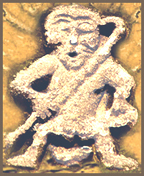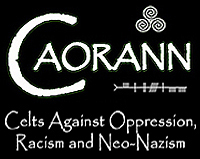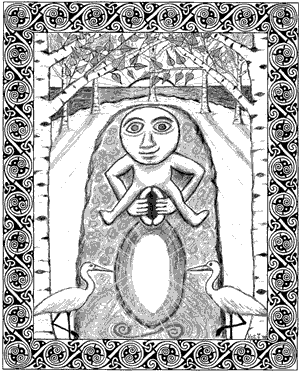|
You stand upon a cliff, high above the sea, in
a misty grove of silver birch trees. The waves crash and scatter on the rocks
below, an eternal sigh of white noise rising. The grey mist swirls around you,
cutting off familiar sights and sounds. Nothing is as it was. Nothing is as it
seems.
Up ahead and above you in the mist, above the
hole in the stone, The Hag of Birth and Death gazes down upon you. Welcoming
and challenging, silently waiting, she opens the door to
rebirth.
In the shifting realm of
liminal space, she reveals to you the gateway – the vulva of woman –
through which every one of us entered this world,(2) through which all of our foremothers entered this
world. Each one emerging from the one before her, all down the line, open
archway after archway, reaching back through time, like a vaulted corridor
leading directly back to First Woman.(2a)
Wise guardian, who knows these roads so well,
who has trod these paths for countless generations. Oldest ancestor, who gave
birth to us all, whose blood runs through our veins. Her cryptic smile hints at
secret knowledge – She can look every challenge in the face without
flinching; She can meet all changes head-on… and laugh. In your mind you
hear her whisper her name: Síla (“SHEE-luh”).
You bend low and touch the earth, offering a
prayer for guidance as you approach this threshold. Out of the corners of your
eyes you sense the mist swirling; spiral patterns form and dissolve around you,
hinting at mysteries, sparking a distant memory, somewhere beyond your
conscious grasp.
You suddenly notice a heron, Síle na
bPortach (“SHEE-luh nah BORT-uckh”), keeping still, silent vigil
nearby. How long has she been there, watching you? ... You acknowledge her, and
her role as guardian of the gate. You open yourself to her, and you can feel
her looking into you, judging you, deciding whether or not she will let you in.
You open without fear (or despite fear) and join with her stillness. You feel
the silvery-white energy of the birch trees entering you. You breathe in their
purifying, focusing, clean and clearing energy... Opening your heart and
stilling your mind. You chant their ancient name, Beithe (“BAY-huh”).
You feel the powers of land, sky, and sea come together and focus within you.
You take a deep breath, and climb through.

“You had
the calling and died wondering—who is it that calls.
We were all
calling. Down from the centuries beseeching you
to release from stone
unparalleled beauty and in doing so
chipping away the stone encasing
hearts.
…you were called…
you remembered us – the
future…
We were calling you and I am calling you now.”
(3)
It started with the birch
tree…
My personal altar (in a household full of altars)
faces a window, looking out over the trees and the lake. There is a birch tree,
one of many, who lives right on the other side of the glass, her boughs
sweeping into my line of sight whenever I’m at my altar. Sometimes when
I’m sitting there, I’ll open my eyes to see chickadees or catbirds
fluttering in her leaves, or through her branches I’ll see herons wading
in the shallows, or otters splashing and playing out where the waters run deep.
The crows and other wildlife come and go, adding their own emphases and omens
to my rituals. And with the curtains open, as they always are, the rays of the
sun, moon and stars light my work.
On this misty, grey day I was on the other side of
the window – outside on the rocky slope, meditating with this familiar
tree. I was asking her about symbols: What symbol, or goddess, or animal,
works best with the energy of Birch? I had made my offerings of menstrual
blood and breast milk, and I sat waiting, opening, huddled in my cloak in the
shade on this cold morning in early spring.
Suddenly, I received a very strong and clear image
of a Sheela na Gig -type figure. She was sitting in a grove of birch trees,
with her knees drawn up, displaying her signature wide-open vulva, and a huge,
almost maniacal grin on her face. She was laughing.

I have to confess, I was startled. I’m a bit
ashamed to admit it, but the Sheela images had always freaked me out a bit.
Much to my relief, this discomfort was eventually worn away, thanks to
Síla herself, and also because I can’t stand feeling inhibited or
uptight about… well, about much of anything, really. And I certainly
wasn’t going to tolerate feeling squeamish about something related to a
vision or a Goddess image. I mean, I was the one who had started this
dialogue… I had asked for the information, and now it was my job to figure
out what to do with it. I figured I’d better start working with this
Sheela who had popped into my life. After all, I didn’t want to be
rude.
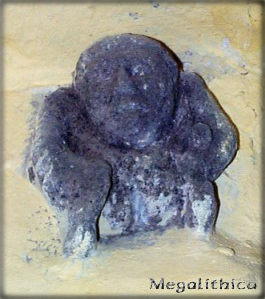
Sheela na Gig - St.
Catherine's Church, Tugford, England.
If you look closely, she's sticking
her tongue out. (!)
Picture courtesy of John Harding and
Megalithica.
Just who is this mysterious figure, the Sheela na
Gig? Is she a representation of the Cailleach – the Hag of Winter, the Old
Woman who lives in the stones? Is she a goddess at all, or rather some
lesser form of otherworldly being? Or were these images merely intended to be
grotesques – carved on medieval churches to shame women about their
bodies, their sexuality, and their power to bring forth life?
When I began looking into
her origins, I encountered this range of questions and opinions among various
polytheists and scholars. At that time, little research had been done on these
images, and even less on the individual being or beings whom they were intended
to represent. (4)
For the moment, I decided
not to worry about these conflicting theories. I felt a deep need to still the
mental voices of the opinions of others and approach her one-to-one, on a
spiritual level. As an experiment, I decided to give her the respect due a
goddess or revered spirit woman, whether she was one or not. I decided to open
to her in the way I would approach a deity, honoured ancestor or nature spirit,
and see what she had to say about it, what she had to show me.
Over the next five years, I experimented with her
(and it seems she experimented with me as well). I did lots of dreamwork and
ceremony;(4a) I invited her in
ritual and prayer, to see if she brought through power, and if so, what kind.
As I got a clearer understanding of her, I became more open to seeing when she
was appropriate to invite into more formal ceremonies – which I learned
largely from noticing when she would simply show up on her own.
She gradually moved into my household. She now
lives over our ancestor altar and our household altar. Surrounded by heron
feathers, cowrie shells, juniper from our garden, and a small forest of twigs
from the silver birch who guards our ritual site, she now dwells on the window
ledge over my personal altar as well – framed by the moving, growing
branches of that same birch tree who seems to have brought us
together.
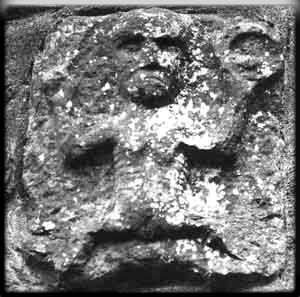
The Kiltinan Castle Sheela
Photo courtesy of Joe Kenny and
The Fethard Historical
Society - Co. Tipperary, Ireland.
Síla
of the Paradox
“If you hold opposites
together in your mind, you will suspend
your normal thinking process and
allow an intelligence beyond rational
thought to create a new form.”
(5)
In some of the Scottish
lore the year is ruled alternately by the Hag of Winter (the Cailleach) and
the young goddess of Summer (sometimes considered to be the goddess
Brigid).(6) Síla is clearly a
manifestation of the Cailleach as Creator, yet she also embodies a paradox. In
some ways Síla is a third face of this well-known duality: the
manifestation of the usually-hidden doorway that emerges when these forces are
balanced or in flux. She holds the doorway which opens in the liminal-times:
the days of Bealtaine and Samhain, the twilight of sunrise or sunset, and when
the mists arise where the land and the sky meet the waters.(7) She is both and neither, an otherworldly force that
refuses to fit into either/or categories.
She appears when opposing energies meet, and she
is also found when the energies of the Three Realms come together. She opens
and holds the center of sacred space – the doorway which opens when we
connect with the powers of Land, Sky and Sea and balance them within ourselves,
opening to the Spirit that flows throughout and unites all three.
I feel her presence in ceremony, when we enter
that stillness, on the edge between this world and the next. I feel her when I
center, when I still myself and find the quiet place of prayer, the silence
from which the voices of spirits can emerge. I feel her protection, her
guarding of the gateway, when the voices of the spirits get to be too much and
she kindly offers her protection – the calm and stillness in the center of
the whirlwind. As the Storm Hags, the Cailleachan, dance around us, Síla
is the crux point around whom the world spins. She is the silence that enfolds
us, the moment as we poise on the edge before diving into a new realm. Her
shining, silver-white energy washes us clean. She opens our eyes and gives us
the strength and courage to begin anew.
She is the saining smoke rising, the blank paper
waiting, the silence in the singer’s head from which the music is born.
Dance me
through to the stillness
to the point where the motion begins.
Dance me through to the silence
to the edge where the world begins.
(8)
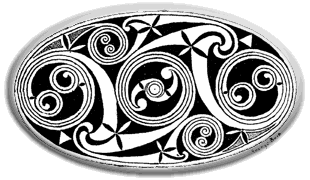
Old Woman of the Stones:
Historical Sheela
In appearance, the Sheela
na Gigs most strongly resemble the Cailleach – our most ancient Celtic
ancestor, the Old Woman, the Winter Hag. Many simplistically refer to her as a
“fertility figure.”(8a)
However, her image combines aspects of fertility and infertility: her
plump vulva, suggestive of youth and sexuality, is stretched wide-open as if in
childbirth, yet in most depictions she has no breasts. In other images, when
she is depicted with breasts they are almost always the drooping, long and flat
breasts of a post-menopausal woman. At times her chest is scarred, with
skeletal ribs, a fierce grimace, and the bald head of either a newborn or an
extremely aged hag. If we take full breasts and bellies to be symbols of
nurturance and material abundance, this is not a nurturing figure. She
seems a creature of paradox and contradiction – representing the primal
extremes of birth and death: the edge-times, the dangerous times.
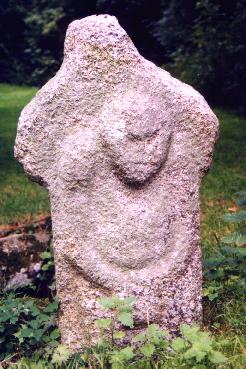
Stepaside Sheela, Co. Dublin, Ireland.
This Sheela may be guarding the entrance to a crypt.
photo copyright
©2000 Tara McLoughlin.
The earliest known sheela-type images have
generally been believed to have been carved in the late eleventh century, on
medieval churches in south-western France, and then later in England and
Ireland from the twelfth through the sixteenth century. However, these images
from Continental Europe, to my eye, do not much resemble the sheelas of the
Insular Celtic lands, aside from being nude females (or, mostly female. -ish.).
While the Continental images I've seen are more likely to resemble human women,
many of the insular sheelas tend to have the
characteristic flat-topped, large, vaguely triangular head and emphasised eyes
of much older Celtic carvings.(8b)
The Insular sheelas are also much more likely to have the wonderfully weird,
otherworldly, androgynous quality which I explore in this article.
The prevailing opinion
among scholars, at least at the time of the first publication of this article,
was that the sheelas are a Christian invention, and that there was no firm
evidence of sheelas at ancient pagan sites.(9) However, I believe this theory could have been due
to incomplete research; more recently I have become aware of two or three very
old figures on standing stones in Ireland. They are very weathered, but I
believe they could very well be sheelas, or at least precursors to the sheelas.
As far as I'm aware, there has been no official dating
of these first two carvings, though some researchers believe at least one of
them to be pre-Christian. A figure that received a lot of publicity in the
summer of 2003 is most definitely pre-Christian, but we're still determining
whether it is in fact a sheela (I think it is). (9a)
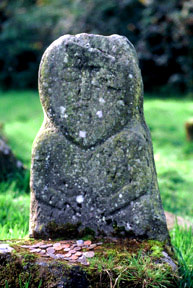
Lusty More figure
copyright ©2004 Shae Clancy
Another fascinating find is the wooden
Ralaghan Figure: “Found in the Ralaghan Bog at
the foot of the Taghart Mountain near Shercock in 1908, this figure is of great
significance as is its find site. It has been radio carbon dated to between
1098 BCE / 906 BCE placing its use towards the end of the Bronze Age. The fact
that the figure was carved of yew was significant as the yew tree was
considered sacred and was believed to have been endowed with regenerative
properties. Taghart Mountain was a hilltop festival site of Lunasa. This site
was used as a place of worship by the late Bronze Age people, by the Iron Age
Celts and into early Medieval times. The Sexuality of the figure is ambiguous.
Quartz grains were found in the pubic hole indicating the possible insertion of
a phallus” - from the info on the museum card. The figure pictured below
is a replica of the original, which is on display in the National Museum of
Ireland in Dublin. While this figure lacks many of the characteristics of the
later, stone sheelas, I believe it could possibly be an early precursor to
those figures. And it makes one wonder what carvings did not survive. That the
carving is of yew is very significant, I believe. In the cycle of the ogham
letters, birch is the first letter (associated with birth) and yew is the last
(associated with death, and with the spirit that survives beyond death). When
we place the letters in a circle, yew and birch are next to each other,
illustrating that death in one world is birth into the next.
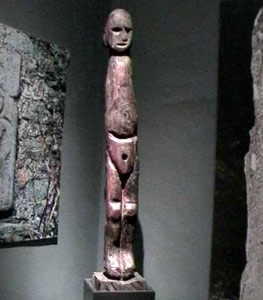
Ralaghan
proto-Sheela. photo copyright ©2003 Gay Cannon
So for now, the question of their date of origin
is still open. We may never know for certain, as the oldest-appearing images -
on standing stones in graveyards - have also been heavily worn by exposure to
the elements, while the ones in churches are more likely to have been protected
(if they weren't defaced by human hands, as has happened in all too many
cases). Ultimately, the question of whether the Insular Sheelas are of
“pagan” or “Christian” origin may be irrelevant, as early
Celtic Christianity was not all that different from the Celtic paganism that
preceded it.
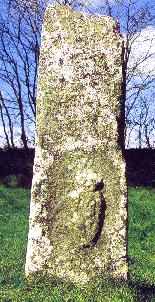
Tara Hill Sheela-na-gig, Co. Meath,
Ireland.
photo copyright ©2000 Tara McLoughlin.
When the sheela images began to become widespread
in Irish churches (12th - 16th cent. ce), the Irish people adopted them
enthusiastically, and also began carving them on secular buildings such as
castles and mills. The term “sheela na gig” is said to have been
adopted by folklorists as “simply the common Irish Gaelic expression for
an immodest woman.”(10) The
reason for the adoption of sheelas on secular buildings has been attributed to
the Irish seeing them as a protective force, as noted by nineteenth-century
researchers who “were told by local Irish people that sheelas were
intended to ward off evil.”(11)
This is reported along with a fascinating claim from a traveler in Ireland in
the 1840s that, in order to lift a curse of bad luck, the afflicted should
“persuade a loose woman to expose herself to him.”(!)(12) Here we see the vulva as holding the
power to bless and protect.
A delicious irony in this
history of the sheelas is that, even if they were introduced into the Celtic
lands as a Christian attack on women, “it seems wise to suggest that the
device of the sheela… was absorbed there into a native belief in powerful
female protectors. These carvings upon the later medieval buildings of Ireland
may, then, have been a last manifestation of the old tutelary goddesses.”
(13)
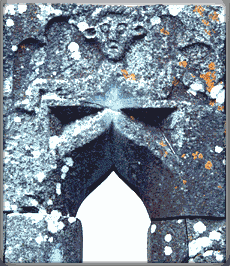
Kilsarkan Sheela, Co. Kerry,
Ireland.
Photo from Tara's Sheela na Gig Page.
In Christian times, She
survived…
Dwelling over church doorways, reminding those
with the ability to see that entering sacred space is to enter the womb of the
goddess – the cauldron of death and rebirth, where we are taken apart and
rebuilt – where we find challenge, dissolution; and then rest, renewal and
change. Reminding people that She is the gateway – we all entered the
world through the womb of a woman. We remained here and grew strong, our
spirits rooting and becoming one with our bodies, through the protection of a
woman: she who in those early days held the life-and-death power of a goddess
over our tiny, fragile forms. No wonder many people find these images
intimidating, frightening, or grotesque.
And She is also the devourer, who takes us back
in at the end of this life – dismembering us, stripping away the
inessentials, until we are pure spirit – transforming us and readying us
for our next turn on the wheel.
When we approach the doorway to sacred space,
or the gateway to life and death, we go with openness and acceptance of the
Mystery: No one truly knows what awaits us on the other side. Will the goddess
who greets you be hideous and challenging? Or will she welcome you with love
and open arms? Are you sure she will even be there at all? And which of these
challenges is truly the hardest for you to face at this point on your
soul’s journey?
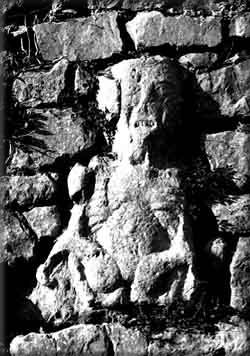
The Watergate
Sheela.
Photo courtesy of Joe Kenny and The Fethard Historical Society - Co.
Tipperary, Ireland.
Word Magic:
Etymological Síla
I initially assumed that sheela was
a phonetic spelling of the popular Irish name Síle.(14) But the question remains – if Sheela
(na Gig) was “simply the common Irish Gaelic expression for an
immodest woman,” and even applied to prostitutes, why on earth would
people choose the name for their daughters?(15) I have to wonder: could traits which came to be
described as immodest have earlier been seen as free,
fierce, or bold – traits which were once highly valued in
Celtic cultures before the advent of Christianity? Could this name have been
applied to rebellious, independent women who refused to be limited by
patriarchal laws that treat women as property? What were the origins of this
name? Why did the Irish start calling these images
“Sheela?”
In tracing Irish words
back to their roots, priority is given to the sound of the words, not the
spelling. Many sounds in Irish can only be approximated in English; variant
spellings in the manuscripts are due to different authors’ imperfect
attempts at capturing the sounds of spoken Irish.(16) The spelling variations which follow are all
pronounced basically the same.
Possible meanings to be explored for
Sheela/Síle include: to shelter or shield; the
seed which is planted and the ground in which it grows; offspring,
race or descendants of; raining; an effeminate person; to think, to
consider, to have respect for; and, perhaps my favorite possibility:
cause or origin.
In Scotland, we find the
word sheiling – a shelter, and sheal – to shelter. Both
are derived from the Icelandic root word for shield.(17) These words are a product of the Northern
influence on Gaelic languages and cultures, and meaning certainly fit with the
protective function of the sheelas.
P.W. Joyce gives the root Shee as a
corruption of the Irish Sidh – a fairy hill.(18) While this is probably too
fragmentary to be the sole answer, it is still an interesting and appropriate
association, especially as the mounds can be seen as both the tombs of the dead
and the belly from which new life emerges. While originally only a word for the
mounds, in later usage sidh also came to be applied to any otherworldly
spirit or creature who might be associated with these places.
The Old Irish root word
síl, or siol (both pronounced “sheel”), seems to
be the strongest possibility. It is from this root that we get the rest of the
above-cited words that could be related to Sheela/Síle:
“síl – seed, offspring, race, descendants. silad –
act of disseminating, spreading, to make known. sílaid – either
the seed, etc., which is sown or the earth, etc., which is sown with it;
causes, brings about, produces; generates, multiplies,
spreads.”(19)
It was while digging through
the Early Irish quotations in tiny print under síl and
sílaid that I found something that really made me sit up and take
notice: sila has been used to mean cause or
origin.(20) And it is
pronounced the same as "Sheela" and "Síle." I felt a chill of
recognition. This resonated so strongly with the intuitive impressions I’d
been receiving in my work with her.
Ever since that moment I’ve found myself
thinking of her as Síla (“SHEE-luh”), First
Woman, Eldest of the Ancestors.(21)
This idea of Síla as “the origin” aligns with my sense
of her strong connection to the ancestors, and the tales of the Cailleach as
the mother of many tribes of humans, whose husbands have all died of old age,
one after another.(21a) I have
generally continued to use this variation in the name, both to distinguish her
from the more common personal name, Síle, in reference to the
manuscript where this spelling was found, and to commemorate that sense of
“rightness” that hit me when I found it. However, many prefer to use
the more common spelling, Síle, and I sometimes do as well. In
many ways Síle (Hag) may be the more appropriate variation,
depending on which meaning one is leaning towards.
In some areas of Ireland,
old women have been called Síle.(22) In more contemporary Irish, we also find
Síle defined as “an effeminate person,
sissy”(23) or “a
girlish young man.”(24)
This brings up an interesting connection to the Hag, as Cailleach –
the well-known Gaelic word for hag, old woman, or veiled one
– is also used to refer to “effeminate” men. In the second
definition of Síle, we find the mention of youth. Here we have
twice the paradox: youth and age, and now the suggestion of gender
variance or androgyny. Gender variance is also seen in Sílaid
meaning “the seed and the ground in which it is
planted,” (emphasis mine) and in the gynandrous appearance (no
breasts, no hair) of most of the sheelas.
Gender variance is also
suggested in Fiona Marron’s experience with the Seirkiernan Sheela: when
Fiona touched her, she felt two small holes atop this sheela’s head, much
like those found on some continental Celtic Cernunnos figures that feature
removable horns. Fiona received a strong impression that, for certain
ceremonial purposes, “the stag king’s horns” may have been
placed upon this sheela’s head.(25) This would also parallel the Scottish associations
between the Cailleach and her herds of deer. The
Ralaghan Figure, with its pelvic hole and possible removable phallus, shows
even stronger gynandrous characteristics.
In these situations and others we see a suggestion
of Síla being in between the two polar points of gender, or as
encompassing both. In many ancient (and some contemporary) cultures,
gender-variant people are seen as embodying particularly powerful magic. They
are seen as holding the paradox-energy that lent them special abilities –
usually the power to cross over into unseen realms and to have particularly
strong connections with the Spirits.(26)
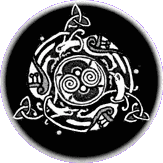
The herons and the double spiral
gate.
From a design by George Bain. This version ©1999 kpn
In Irish we also find
Síle na bPortach (“SHEE-luh nah BURT-uckh”)
– the heron.(27) The heron is a
liminal-dweller, living in the misty wetlands of marshes and swamps, and at the
edges of rivers, lakes and oceans. They are sacred creatures who travel in all
three realms: Land, Sea, and Sky. Herons like to nest in tall pine trees, a
sacred tree that is associated with rebirth in the crann ogham.
Portach means bog. Port means place of refuge, haven,
center; fortified place, stronghold.(28) Again, we have themes of protection and a hag who
guards the sacred space.
Herons are often
interchangeable with cranes and storks in Celtic mythology, language and
iconography. The word Corr, usually translated as crane, has been
used interchangeably for these three similar birds.(29) “There are many references to cranes in
Celtic mythology as female guardians of Underworld sacred sites… Cranes
were clearly associated with the world of the dead, and with beings who seemed
to bridge the worlds of the dead and the living with their insight –
particularly old women.”(30)
In European folklore we
find the image of the Stork carrying infants to their birth parents (a tale
which has probably survived due to adults’ discomfort at answering the
children’s question, “Where do babies come from?”). I believe
The Stork could be a surviving reference to the magical role of these liminal
birds: guides and guardians who carry spirits from the Land of the Dead (in
Gaelic mythology found on islands across the western sea), carrying them over
the waters and into this earth-realm, enabling the spirits to
(re-)incarnate.(31)
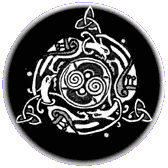
Gig is much
more obscure, and has been interpreted in a variety of ways by different
researchers. Among many writers, the most commonly-repeated, yet highly
questionable, theory is that the name was originally from one of two possible
Irish phrases, “Sighle na gCíoch(sheela of the
breasts)” or “Síle-ina-Giob (sheela on her
hunkers).” While the construction Sighle na gCíoch is
phonetically somewhat similar to “Sheela na Gig,” we've also seen
that so few of the sheelas actually have breasts. And the few that do... well,
their haggish breasts are really not the most, er, prominent of their
features. While Síle-ina-Giob better fits the physical appearance
of a number of the sheelas, I just don't see the word ina-giob migrating
to the words na gig, in either pronunciation or spelling, during the
time period in question. So I have never found either of these speculations to
be credible. They both seem to me to have been arrived at by the same type of
process I have followed in preparing this article -- an attempt at
reconstructing a meaning in retrospect, rather than discovering a phrase that
was actually gathered in the field during the time periods in question.
(31a)
One theory that is worth consideration is that
Gig could be based on the contemporary Irish and English slang term for
vulva or vagina: Gigh (“Gee” pronounced with a hard
“G” as in the English “go,” but also heard in some areas
with a soft “g,” as in the English “gesture” or the
American “gee whiz”). While this is an obvious candidate, more
research needs to be done to determine how old this term is, and whether it is
of Irish or English origins. 31b
Gig could be related to the Gaelic word
gìog (“geeg”), meaning crouch or to sneak a
peek at.(32) Sheela is crouching
in many of the images, and she is giving people a peek at what is normally
private. Or perhaps it came from the Middle English/Old Norse word gigge
– whirligig or spinning top, from which we get gig – to
reproduce another of the same sort (hmm, parthenogenesis?) and gig
– a small boat.(33) Many
boats are in the shape of a vulva, and this again brings to mind the function
of crossing over – crossing over the waters, whether in physical birth, or
in the spiritual journey to and from the Otherworld islands of the
dead.
Something I believe to
also be worth consideration is Nigheag - another name for the
Washer at the Ford. “Nigheag nan Allt, the washing-nymph of the
streams” is an otherworldly Hag, often connected with the giving and
breaking of geasa, with prophecy and punishment and the granting of wishes.
Because of the Ni sound, and the g being lenited, it wouldn't be
pronouned the same as “na gig”. It sounds more like
“NEE-yuhk.” But visually the two are very similar. As Sile and
Nigheag nan Allt both refer to otherwoldly hags, I think this is a
notable connection.(33a)
I had basically finished
writing this article, and was putting away my reference books. As I picked up
the Gaelic dictionary, it slipped from my hand and literally fell open to:
geug (“gayg”) – a branch, a sapling, a young
female, a nymph.(34) In Irish,
the word is spelled géag (same pronunciation, basically)
and can mean Genealogical branch (of a family tree) or Image of a
girl (made for the May festival).(35) Both words come from the Early Irish word
géc or gég– a branch, a bough, a
respected person.(36) In both
Gaelic and Irish, the genitive form is géige
(“gayg-e”).(36a)
Géag also links Sheela to the
Cailleach and Cailleachan through the early Spring festivals of Là na
Caillich in Scotland, where the celebration is often interchangeable with St.
Patrick's Day; Sheelah's Day, which is observed in Ireland on the day after St.
Pat's; and in Newfoundland, a day known as "Sheilah's brush," also on or around
March 18.(36a1) In Newfoundland,
"Sheila's brush" (or "blush") refers to the "...fierce storm and heavy snowfall
about the eighteenth of March," and she is described as walking the shore in a
long white gown (i.e. of snow). In Ireland, it's said that if it snows on or
around St. Patrick's Day, "Sheila is using her brush" (snow as dandruff!).(36a2) Then just last year (2013) we
discovered an account of a German traveller in Ireland, in 1843, who was told
that "Shilah na Gigh" meant "Sheela with the branch."(36a3)
Again we have a branch or
brush, and the connection to the tales of the Cailleach freezing the earth by
striking it with a stick. Here we have the Hag holding the power to usher in
either winter or spring with her magical branch, not unlike the magical branch
that, in other tales, Otherworldly women use to bring about a change in the
world, such as shifting the human who encounters her into the Otherworld. Here,
the Hag waves her wand and raises the storms that shift us into another season.
In all of these early-spring festivals we see
terminology for the Hag and Hags - Sheelah, Cailleach etc - being used
interchangeably for the being associated with the final blasts of wintery
storms around this time of year, and whose day on March 25th signifies the end
of them (hopefully). And as noted above, there are megalithic alignments in
Ireland, named for the Cailleach, which are oriented to the equinox solar
phenomena.(7)
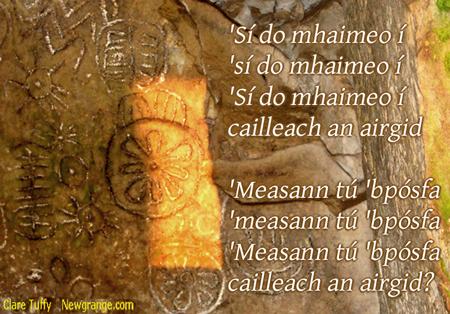
equinox illumination: photo by Clare
Tuffy, text from traditional song added by kpn
In entry #385 of the Carmina Gadelica, we
have an autumn waulking song with the curious line, “But mayest thou sow
them and Géige reap them.”(36b) Could this also show a connection to the harvest
“Maiden” and “Cailleach” customs (“an image of a young
girl, made for festival”), with the Hag as the reaper and/or the corn that
is being harvested? Or be yet another connection to the Nigheag nan Allt as a
death figure? In Gaelic folklore, Géigean (which,
paradoxically, can also be seen as a diminutive form of géige) is
a “wild man” or “gruagach” type figure – depicted as
fierce and hairy, with connections to “death revels,” and the
festival of Samhain.(36c) Some
women in childbed, with no knowledge of Sheelas or Gaelic Hag folklore, have
perceived a Hag spirit accompanied by a heron, connected with birth and death,
who is covered in hair like the wild man figures.(36d) Tapestrys and old drawings depict both male and
female “wild men.” These Gruagach figures are often tricksters in the
folklore and, like the Cailleach, are also associated with herds of deer. In
traditional rhymes and tales, the name of this figure varies, and has been
recorded as Géige, Gìgean, Guaigean, Céigean,
Cìogan, Cìgean, and Cuaigean. Dwelly gives
ceigean as “diminutive and unhandsome person.... clumsily formed
and of low stature.”(36e)
Could the older words for Sheela na Gig have
originally meant something like “Origin of our Branch of the Family,”
“Origin of the People,” “Origin of the Tribe,” “Image
of the Hag-Spirit Who is Also the Spring Maiden” (literally, “Hag of
the Maiden”), or “Wild Hag Trickster Spirit, Who Rules Over Birth and
Death''? Or perhaps any number of variations on these concepts? After all, the
Gaelic mind has always loved puns and multi-leveled meanings.
Síla of the branches,
Origin of the Tribes
Síla of the nymphs, Origins of Womankind;
Eldest of the Ancestors, gynandrous crone and fertile youth,
Hag and
Maiden and in between; seed and ground and truth;
Síla of the
bloodlines, Síla of the trees,
Síla na Géige
Sheela
na Gig
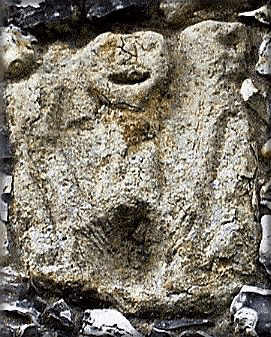
Buckland Sheela - All Saints
Church, Buckinhamshire, England.
Picture courtesy of John Harding and
Megalithica
Ceremonial
Síla
“wise with age and the
androgyny of time”(37)
“the ageless perfect center”(38)
Síla is the Otherworldly gate of Mystery,
The gateway of All Possibility, but also the power to focus – to reach
into the “sea of possibility”(39) and draw something into manifestation in this
world of forms (“seize the possibility”).(40)
My sense is that she controls whether the gate is
open or shut, and that, through aligning with her, she may confer some of this
ability and wisdom upon her allies.
When present in ceremony, the sacred space
Síla creates gives me the distinct feeling of being “between the
worlds” – not yet completely in the Otherworld, and no longer fully
in this world, but in a liminal, charged, basically neutral space from which
one can then choose a direction or destination. Síla seems to specialize
in this liminal zone, the doorway, the center and the edge, where one can pause
and center oneself before fully crossing over. Or she can help build a
protected space in which one can stay and invite other spirits to enter. Some
of this energy and perception, I’m sure, is based on the power of the
birch trees, and how closely I was working with them when I began this
piece.
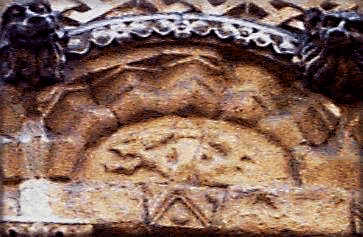
The Rochester Cathedral
Sheela, Kent, England.
Picture courtesy of John Harding and
Megalithica
Síla of the Trees
Saining with the smoldering
juniper, our prayers rise with the smoke – dancing and
spiraling into
the sky. Bathing ourselves in the scented, energy-filled clouds,
opening
ourselves to the cleansing wind blowing in from the sea.
“Am goeth i
muir” – I am a wind on the sea.
In the Irish ogham lore Birch is associated with
birth, beginnings, cleansing and purification, and the type of healing that
comes from these energies. Cradles were made of birch to keep fragile newborns
safe from unfriendly spirits. An early ogham tale also speaks of birch as a
protector: it was used to protect a woman from being abducted into the
Otherworld.
Like Síla, birch is both a guardian and a
gateway. In my experience, they work together synergistically. Part of
birch’s protection – if she grants it to you – is that she
doesn’t so much banish spirits as set limits and create a
“breathing space” of peace and clarity, from which one can then
choose where to go or who to let in or keep out. The energy of birch and
Síla, like juniper smoke, will clear away bad vibes and create a clean
and sacred space from which to begin your spiritual work.
Birch can also be a
helpful ally for those with mediumistic tendencies. Sometimes the presence of
the spirits can become overwhelming. A reliable method of setting respectful
limits with the spirits is essential. Those dealing with this gift/predicament
need to create firm structure to keep sane – keeping altars for the
spirits and making clear to them that the altar is where they stay, not in your
head. Giving the spirits a defined place to hang out, and working out a
schedule of rituals – regular times for you to check in with them and do
your work together – are ways to prevent them from overwhelming you at
inappropriate times.(40a) And when
you do your spirit work, birch helps to create a safe space within which you
can selectively open.
In my experience this
“protection from spirits” function also extends to dealing with
alcoholism. Birch and Síla have an energy I’ve found helpful to
those in recovery, especially to those in the early stages of getting clean and
sober. Their white, clean, Obatala-type(41) energy can be very stabilizing to those stepping
through the doorway into a new life of sobriety. Síla and birch might
also be helpful in helping people cope with with schizophrenia, though as in
any case of serious mental illness, only as an addition to medication, not as a
replacement.
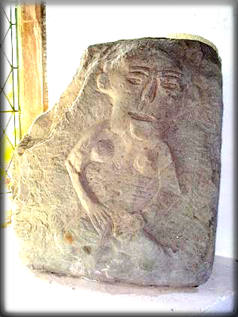
The Llandrindod Sheela, Powys Mid
Wales
Picture courtesy of John Harding and Megalithica
Síla, Sheela, and
Sacred Space
In the twilight of dawn’s
light
She stirs the mist
From the Edge and the Center
The energy
shifts
(from the edge and the center)
(the world shifts)
I see “sacred space” as having at least
two meanings. First, in the more “mundane” and political sense: The
Earth, our bodies, and all the Earth’s lifeforms are, in one sense or
another, sacred. And second, the way many ceremonial people use the term: A
space that is particularly charged with spiritual forces and the presence of
powerful spirits, and which perhaps contains entrances to the spirit worlds.
Earth is always sacred in the first sense; and she also has sacred sites, which
are sacred in the second sense, whether or not humans ever pray or hold
ceremony there.
So part of what makes sacred space sacred is that
it is energetically and spiritually different from other spaces. It may be
safer, it may be more dangerous, but it deals with different levels of reality
than we access in “ordinary” consensus reality. Though the sacred and
the mundane certainly flow into and inform one another - and are particularly
known to be interwoven in the Gaelic traditions - for those who are sensitive
there has to be some boundary between them. Otherwise, you can lose yourself in
the mist, and you can lose your ability to be fully in either realm. This is a
hazard many spiritually sensitive people deal with, with varying degrees of
success and failure. My work with Síla and birch is one of the more
successful ways I’ve dealt with this challenge.
When my work with Síla first began, I
connected overwhelmingly with her spiritual gateway function and her role in
establishing and protecting sacred space. I was working with her primarily in
ceremony; in deeply altered states of consciousness. At that time, putting
Síla over the doorway to our house would have felt like I was asking
that the entire time I am in this house I should be in an altered, extremely
deepened state, completely focused on communing with the Spirits. I've tried
living that way, and it's not very practical. So for the first few years, she
stayed over the altars.
But after working with her for over twenty years
now, I’ve gotten better at mediating the difference between simply having
a Sheela na Gig image present, and actively asking Síla to open the
gateway. So much so that it's now a subconscious (or at time unconscious) way
of how I am in the world, all the time. Now that I've had some time to
integrate and ground the energies she brought into my life, I've become more
aware, and appreciative of, her more general and “mundane” protective
powers, and how she is the rightful guardian of liminal places like doorways.
Learning to balance the interwoven nature of the spiritual and the physical is
one of the prime challenges and gifts of Gaelic Polytheism, and now that my
life is more fully reflective of that, and that I've had more decades to mature
into that role, her multiplicity of roles makes more sense to me as well. So,
in the tradition of other Gaelic protective charms, like rowan crosses, she not
only lives above the altars here, but a certain sheela now guards the doorway
to our house, as well.
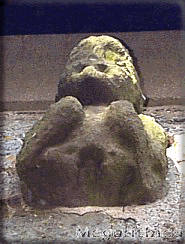
The Holdgate Sheela - Shropshire,
Tugford, England
Picture courtesy of John Harding and Megalithica
In Conclusion
So Who is Sheela/Síla – Goddess,
Grotesque, or Otherworldly Power? Well, these things are not always clear-cut
in Gaelic matters – Powers and Beings can flow, shift, change and have
agendas of their own, and Síla is no exception. The Otherworldly Being
I’ve contacted through my work with Sheela na Gigs and the birch trees,
Whom I call Síla, is a trickster and shapeshifter; she is one of the
sacred Hags (Cailleachan), and probably a face of the Hag herself. She’s a
primal force, older than human speech.
I believe she is our most ancient Gaelic
ancestor, and the closest thing we have to a Creator spirit. Her story can be
found in the tales of the Cailleach, most notably the ones where she creates
the lochs and mountain ranges of Scotland, or guards the gateway to the
Otherworld of the Western Irish Sea. She is also seen in the sovereignty of the
land, and when she herds her deer down by the shore. (42) Her face is seen in the shifting shape of the
land.
In ceremony she arrives as
a distinct energy and presence, who “speaks” through shifting
energies and granting visions, and rarely if ever speaks in any human language.
She is older than human language. Her language is the shifting of the stones,
the sighing in the branches of the trees, the waters crashing on the shore
below the cliffs, the gale howling over the turbulent sea.
When this style proves too vague for our limited
minds, she tends to send more recent ancestors, via vivid dreams, to articulate
the specifics.
Like the many individual and unique sheelas found
throughout the Celtic lands, the face Síla reveals to you may vary
drastically, depending upon the land where she is invited, the situation
regarding the sovereignty of that land, the particular relationship you and
your ancestors have with her, and upon your relationship with the land and the
otherworlds in general.
We have no way of knowing for certain if my
conclusions about Síla resemble the specifics of what our distant
ancestors believed about the carvings. Though the tales of the Cailleach are
solid and unwavering, and live in the Gaelic cultures up to the present day,
not every researcher who has looked into the sheela carvings has concluded they
are votive figures of the Cailleach. For our recent Ancestors, it certainly
seems that many of the sheelas were not initially commisioned as figures of
veneration, and that any spiritual powers and beings that have come to be
attached to these images emerged at a later date – after they took root in
Ireland, and more recently in the more polytheistic pockets of the Celtic
Nations and the diaspora. However, especially given the most ancient carvings,
it is also possible that the earliest sheelas were created by our more
distant, polytheistic ancestors, or that they had images that were so similar
to the sheelas that the two streams of iconography merged. Whichever theory one
believes – whether it's due to their pagan, or despite their Christian,
origins – it seems clear that the images are now Spirit-suffused: that
older spirits, goddesses even, have seen fit to influence the artists and come
through the sheelas – to attach themselves to the images and dwell amongst
us today.
This is simply one spiritual worker's account of
how Síla has manifested in my personal work and among the ever-widening
group of people with whom I’ve shared these ideas and related ceremonies.
One of my reasons for publishing this article, and now maintaining this
website, is to see how others resonate with this information. And, well... She
was getting on my back about putting it out there.

All praises to Síla of
the Paradox:
The boundary, the border,
the edge and the center;
The sunset and sunrise,
She of the sly
grin, She of the wide eyes;
Grimacing crone, Life-giving hag,
the
heron, the crane, and the stork with her bag.
Spinning and laughing,
Paradoxical Crone,
Opener of the Way, Old Woman of the
Stones.
Dancing in dawn’s light
Capering in twilight
Sharply awakening
The Hag of the Stones
Sends rays of light piercing
Clarity burning
Deep in your heart
Deep into your bones


Kathryn Price
NicDhàna
is living by the Hags' Brook in the Northeastern
Forest,
hanging out with the Spirits, listening to the trees,
and
writing it all down.
She serves on the governing councils of
CAORANN and
Gaol Naofa, and can be
reached via her blog
or twitter
The original version of this
article appeared as Síla of the Trees in the “Sacred Spaces,
Sacred Places” issue of Sagewoman Magazine (Winter '98/'99).
It
has been substantially revised and expanded for the
web.
Notes on updates can be found on
the front page.
This
article is copyright ©1998, 2006, 2012, 2014 and may not be reprinted
without the express, written permission of the author.
First revision:
ThornBlossom Moon, 2006
Latest revision: Là na Caillich 2014
|

Footnotes:
(1) Language Note: In this article I have
used the phonetic spelling sheela to indicate the Sheela na Gig
images, and the Early Irish spelling Síla to indicate the
Otherworldly Being or Goddess whom I believe the images may represent. The more
common Irish personal name, Síle, is also a perfectly
correct spelling. All three are pronounced the same. All pronunciations are
approximate – the Celtic languages contain sounds not found in English,
and pronunciation varies regionally. For more on her role as a Creator, see
also page 30 of the
Gaol Naofa Gaelic
Polytheist FAQ.(back)
(2) For those born by C-Section - who exited
their mother's body through the belly, not the vulva - this may be merely
symbolic. Yet note how wide-open the passageway is, and how it goes all the way
up into her belly - even the largest of newborns could fit through that gate.
(back)
(2a)Cydra R. Vaux of
the The Woman Sculpture
Site made a sculpture of my vision. Honour and gratitude to Cydra.
(back)
(3)
Patti Smith,
Early Work (New York: W.W. Norton, 1994), p. 169. (back)
(4) Notable recent exceptions in the US: Lori
DeMarre, “Sheela na Gig (Interview with Irish Artist Fiona Marron),”
The Beltane
Papers Issn 4 (Samhain, 1993), pp. 4-11. Ronald Hutton, The Pagan
Religions of the Ancient British Isles (Oxford, U.K. and Cambridge U.S.:
Blackwell, 1995), pp. 308, 310-15.
¶ (Update, 2/4/00): A caveat
about Hutton - While he was one of the only “scholarly” sources
available in the US when I began this article, I've since realized how
incomplete some of his research is. While his books are generally excellent
studies of history in relation to Neopaganism, his research on sheelas is
superficial at best. He has neglected to mention the sheelas that contradict
his theories. Whether this is due to incomplete research or other factors, I
cannot say. However, I apologize for my former high reccomendation of this
book. I still think it's worth reading as a general work, but in my opinion it
should be approached with the same amount of critical thought with which one
approaches the feminist scholars of whom Hutton is so critical.
¶ On a
much more positive note, thanks to the internet, many scholars are now in touch
with one another and great progress is being made in investigating the sheelas
- they are no longer being totally neglected. See our
Sheela Links
section for some of these fabulous resources. (back)
(4a) Traditional
Gaelic and
Celtic Reconstructionist methods of
opening to vision include
praying
with traditional poetry in the Gaelic languages,
making
offerings to the spirits, listening to the spirits, and other techniques of
fisidecht, such as those practiced by the fili or
fáith. In Gaelic cultures, these visionary abilities are
something one is born with, and usually the person is also born into a family
with a long history of these gifts. While it is possible for people born with
these gifts to learn to better control and utilize them, people who have
inherited these abilities are almost always recognized in childhood or at least
by adolescence. Some who are promoting offensive ideas of "Celtic Shamanism"
have expressed interest in the work I discuss in this article. But when I speak
of visionary and ceremonial work, I am in no way referring to any of the
appropriative neo-shamanic traditions out there, including those who claim to
be Celtic. See the CAORANN site for more on my views of "shamanism."
(back)
(5) Niels Bohr, physicist, quoted in “The
Art of Genius,” The Utne
Reader Issn 8750-0256 (August 1998), p 76. (back)
(6) The Spring Maiden is sometimes considered to
be the goddess Brigid. In much of the Gaelic lore, the year is divided into
halves - Winter: Samhainn to Bealltainn (ruled by
the Hag); and Summer:
Bealltainn to Samhuinn (ruled by the Spring Maiden or Brigid). Samhainn and
Bealltainn are the Scottish Gaelic names for Halloween and May Day. This
duality is also seen in Ireland with the summer ruled by the goddess
Áine (of an ghrian mhór - the large, red sun of
summer), and the winter by her sister Grian (an ghrian bheag -
the small, pale sun of winter).
This video from The Irish Film Board beautifully
illustrates how The Hag renews herself as she renews the land.
(back)
(7) In the pre-Celtic stoneworks of Ireland and
Scotland, there are equinox alignments associated with the Hag, such as at
Loughcrew/Sliabh na Caillí, where both the
spring and fall equinox sunrise illuminates the back of the chamber, which is
covered with symbolic carvings, many of which look to be depictions of the sun.
While the Equinox seems to be the main crux point, The
Day of the Hag can come as early
as March 18, Sheela's Day in Ireland, or April 6, the old date of Là
na Caillich in Scotland. (Also spelled Latha na Cailliche, modern calendar
date, March 25). For many of us the equinox has always felt more like her time,
and putting all this information together has confirmed this. As the Cailleach
is most likely based on a pre-Celtic spirit woman, a Creator spirit native to
the isles of Scotland and Ireland, it makes sense that the equinox, with its
pre-Celtic megalithic alignments, is more her time than the later, Celtic
liminal festivals. (back to "Síla of
the Paradox") (back to "Géag")
(8) From “dance me through,”
darkmoon song cycle ©1989 kpn/katharsis ink. (back)
(8a) “Fertility Figure” usually being
archaeological and anthropological shorthand for “we have no idea.”
Often applied dismissively to any female figurine about which insufficient
research has been done. Or, to paraphrase Judy Grahn, “'Fertility
[Figure]' is one of those generalized terms used to vaguely describe what is
imprecisely understood.” (back)
(8b) Almost any well-illustrated Celtic Art
book with Celtic stonecarvings will illustrate this point, but here are a few
references I've compiled in the Illustration Notes. (back)
(9) The exception being the Pagan sacred sites
where churches were later built and the sheelas carved over their doorways.
However, many who have observed the sheelas in situ have noted that some appear
to be much older, more worn, and sometimes of different stone than the
surrounding structures on which they are mounted. Some believe this could
indicate that the carvings of the sheelas existed before the churches were
built. (back)
(9a) For two Irish sheelas on standing stones,
see
Stepaside Sheela, Co. Dublin and
Tara Hill Sheela-na-gig, Co. Meath. Photographs and
commentary by Tara McLoughlin, on her fabulous
Tara's sheela-na-gig Website.
¶ In the summer of
2003, announcements went out in the media that a “new” figure had
been found that may predate all of these:
Historic stone carving uncovered in Co Fermanagh. However,
it was a figure already fairly well-known, at least to locals and those in
Celtic studies. To those of us looking at the photos, this “carved stone
image, originally from a graveyard on nearby Lusty More Island, [which] has
possible links to the renowned Janus figure at Caldragh Cemetery on Boa Island
” sure looks like a possible in situ sheela to us. The Boa Island figures
are estimated to be around 2,000 to 3,000 years old. These two-faced
“Janus” figures' possible connection to the gatekeeper function also
seems very significant. If you look at the photos, she also has coins and
flowers at her feet - offerings from those who visit her.
¶
Ironically, this “new” find, is in a picture on plate 22 of John
Sharkey's Celtic Mysteries - The ancient religion (New York: Thames and
Hudson, 1975) (back)
(10) Hutton (1995), p.311. Australian slang
usage seems to also support this meaning: as their white population began as a
British prison colony, perhaps the word was imported with Irish prisoners.
(back)
(11) _____, p.314 (back)
(12) Ibid. (back)
(13) Ibid. (back)
(14) Alternate spellings of Síle
include Sheila, sheela and sheelagh. Síle is also used to
translate Julia and Cecilia. (back to "Etymological Sheela") (back to "Géag")
(15) Perhaps to honor St. Cecilia, patron of
music, or St. Julian, patron of travellers and boaters? Actually, the quote,
“simply the common Irish Gaelic expression for an immodest woman”
comes from Hutton (1995), p. 311. As we've had so much trouble finding
any Irish Gaelic meaning for Sheela na Gig, let alone a
“common” one, I have to question Hutton's research here. Sadly, I
wouldn't be surprised to hear he has no Gaeilge. (back)
(16) P.W. Joyce, “Irish Place Names”
in Ronan Coghlan, Ida Grehan, & P.W. Joyce, The Book of Irish Names
(New York: Sterling Publishing, 1989), p.85. (back)
(17) Websters Unabridged Dictionary, 2
vols. (U.S.: William Collins & World Publishing, 1975), pp.1671, 1669.
(back)
(18) P.W. Joyce (1989), p.114. (back)
(19) The Royal Irish Academy, Dictionary of
the Irish Language (Antrim, N.Ireland: Greystone Press, 1990), pp.542-3.
Malcolm MacLennan, A Pronouncing and Etymological Dictionary of the Gaelic
Language (Edinburgh: Acair/Aberdeen University Press, 1991), pp. 299-301.
Niall Ó Dónaill, Foclóir Gaeilge-Béarla
(Éireann: Mount Salus Press, 1992), p.1092. (back)
(20) The Royal Irish Academy (1990), pp.542-3.
See also the online version, eDIL, under both sila and síla.
Whether fadas are used in manuscripts from this time period can be a bit hit
and miss, so we have to take both the accented and unaccented spellings into
account. (back)
(21) When I speak of Síla as the Eldest
of the Ancestors, I’m invoking the oldest Spirit Woman native to the
Insular Celtic lands. I am also including the fada in the spelling as this
gives a clearer representation of the pronunciation, and because I belive it is
probably the original spelling (in transcription errors, it is usually for more
common to find that a fada has been forgotten where needed rather than added
without cause).(back)
(21a) Though this association has not
persisted as strongly as that of her connection with the land, she may have
some ties to the sea as well. In Scotland, the Cailleach herds her deer down by
the sea shore, and in Ireland, the Cliffs of Moher (Ceann Caillí
- Hag's Head) reach out into the Western Sea, across which the dead journey on
their way to the afterlife. I later came across the
The Rochester Sheela na Gig, who holds a fish in each hand
and strongly resembles the Celtic double-tailed mermaids found on standing
stones and manuscripts.
The
Kildare Sheela is in a similar posture, as is
The Glendalough Sheela and the merperson from the Meigle,
Perthshire standing stone in George Bain's “Celtic Art” (New York:
Dover, 1973) p.120, plate V. An image I've seen, said to be of the Norse
Goddess Freya, is also very similar, but I don't know the background or
veractiy of this design (had a link but the page is gone now).(back)
(22) DeMarre (1993), “used to describe old
women in…County Cork.” (back)
(23) Ó Dónaill (1992), p.1092.
(back)
(24) Tomás De Bhaldraithe,
English-Irish Dictionary (Éireann: Criterion Press, 1992), p.
297. See also
Who is Sheila? by Dymphna Lonergan on use of the word to
describe effeminate men in both Ireland and Australia.(back)
(25) DeMarre (1993). Seirkiernan Sheela, County
Offaly, Ireland, 13th-16th cent. C.E. (back)
(26) Judy Grahn, Another Mother Tongue
(Boston: Beacon Press, 1990). Randy Connor, Blossom of Bone (New
York: HarperCollins, 1993). (back)
(27) O’Donail (1992), p.1092.
(back)
(28) ________p. 965. (back)
(29) De Bhaldraithe (1992), pp. 336, 157, 711.
MacLennan (1991), p. 101. (back)
(30) Alexei Kondratiev, “More on Saint
Patrick’s Snakes and Other Irish Critters,” Our Pagan Times
Vol. 4, No. 4 (April, 1994), p. 19. See also: Katharine Briggs, An
Encyclopedia of Fairies (New York: Pantheon Books, 1976), pp. 57-60, on the
Cailleach as a guardian of animals and wells, and how on the Isle of Man, where
She is known as Caillagh ny Groamagh, or the “Old Woman of Gloominess....She
is said to have been seen on St. Bride's day in the form of a gigantic bird
[emphasis mine], carrying sticks in her beak.”(back)
(31) The species of marsh-bird fulfilling this
role seems to vary regionally, depending on which is found on the land in
question. (So, does this mean that in tropical realms Síla’s bird
form is the Pink Flamingo?(!)) (back)
(31a) It is unclear where these two theories
originated. It is likely they were first published by Dr Jørgen Andersen
in his 1977 publication, The Witch on the Wall: Medieval Erotic Sculpture in
the British Isles. Eamonn P. Kelly also mentions them in his 1996
publication, Sheela-na-Gigs: Origins and Functions. I have been very
surprised at how few have been willing to question those guesses.(back)
(31b) For more on this see Gay Cannon's
fabulous site: Ireland's Síle na Gigs. There was also a discussion
on the problems with the theory on
Old-Irish-L.(back)
(32) MacLennan (1991), p.180. (back)
(33) Websters Unabridged Dictionary
(1975), p. 770. (back)
(33a) Alexander Carmichael, Carmina
Gadelica, (Hudson, New York: Lindisfarne Press, 1992), p526. Text notes to
entry #536.(back)
(34) MacLennan (1991), p. 179. (back)
(35) O’Donail (1992), pp. 616-17. Dineen
specifies that géag can refer to "an image of a girl made on Patron day
(Aug. 10) and the May festival. ef. bábog;" - Dinneen, Patrick S.
(Dublin,1927) Foclóir Gaedhilge agus Béarla, p.522. In
other words, "Bábóg na Bealtaine, maighdean an
tSamhraidh..." ~ "Mayday doll, maiden of Summer..." (from
Thugamar Féin An Samhradh Linn).(back)
(36) The Royal Irish Academy (1990), p. 357.
(back)
(36a) The genitive form is the possessive. So,
for example, when coupled with na or nan, it means
“Síla of the branch” or “Origin of
the Tribes” instead of just “Síla branch” or
“Origin Tribes.” In the pronunciation of géige -
“GAYG-uh” or “GAYK-uh” the final “e” should
really be a schwa (but I couldn't figure out how to make one in any of the
available fonts). And depending on dialect and formal vs informal conversation,
the final “e” may or may not be voiced. Na Géige is the
genitive singular. The genitive plural is more commonly written nan
geug, but with a bit of poetic license it could also be written nan
géigean - it's a pun on an obscure word from Cormac's glossary:
“gigean , geigean - master at death revels (Carm.)”
found also in
McBain's online dictionary. With Síla's
“doorway between the world of the living and the world of the dead”
connections, I particularly like this pun, even if most people won't get it.
“Gigean, a dwarf; said too of a naked child.” (MacLennan, p.
180) - The sheelas don't really resemble children, but they are small and
naked. (back)
(36a1) Story, George Morley (Toronto:
University of Toronto Press, 1982)Dictionary of Newfoundland English,
p.469 (Sheelah's Day, March 18, and the appellation of the
"Equinoctical Gales" as "Sheelah's Brush" or "Sheelah's Blush").(back)
(36a2) Loughlin, Annie, (16 March 2013), "Sheelah's
Day," Tairis: A Gaelic Polytheist Blog.(back)
(36a3) Kohl, Johann Georg (Arnoldische
buchhandlung, 1843), Reisen in Irland,
pp.205-8:
"Caecilie mit dem Zweige." As seen above, Cecily or Cecilia
is usually Gaelicised as "Síle," and vice versa. As for "Sheela of the
Branch" being in use in the 1800's... Yeah, I know. I had no idea. I thought I
was the only one who had come to this conclusion. But it's always good to get
confirmation on these things. This is an excellent example of having something
come to us by intuition or spiritual sight (or weird things like dictionaries
leaping off the shelf) and later getting confirmation via older sources.(back)
(36b) Carmichael (1992), p526. Entry #385,
Verses made at the waulking frame: “Thou girl over there, may the
sun be against thee! / Thou hast taken from me my autumn carrot, / My
Michaelmas carrot from my pillow, / My procreant buck from among the goats. //
But if thou hast, it was not without help, / But with the black cunning of the
dun women; / Thou art the little she-goat that lifted the bleaching, / I am the
little gentle cow that gave no milking. // Stone in shoe be thy bed for thee, /
Husk in tooth be thy sleep for thee, / Prickle in eye be thy life for thee, /
Restless watching by night and by day. // May no little slumberer be seen on
thy pillow, / May no eyes be seen upon thy shoulder, / But mayest thou sow them
and Géige reap them, / And Morc garner them to the green
barns!”
¶ For a wealth of info on the Michaelmas and other harvest
traditions, including info on the Cailleach and those grain and carrot rituals,
see: F. Marian McNeill, The Silver Bough - Vol. Two - A Calendar of Scottish
National Festivals - Candlemas to Harvest Home(Glasgow: William MacLellan,
1959).(back)
(36c) Ronald Black (ed), John Gregorson
Campbell's Superstitions of the Highlands and Islands of Scotland and
Witchcraft and Second Sight in the Highlands and Islands (Edinburgh:
Birlinn, 2005), p.457. (back)
(36d) Private correspondence and conversations
with author. (back)
(36e) Black (2005), p. 457. (back)
(37) Sheri S. Tepper, Gibbon’s Decline
and Fall (New York: Bantam, 1997), p. 452. (back)
(38) Smith (1994), p. 155. (back)
(39) Patti Smith, “Land,”
Horses (New York: Arista Records, 1975). “I hold the key to the sea
/ of possibilities...”(back)
(40) Ibid. (back)
(40a) Modupue (many thanks) to
Teish for teaching me
this survival skill. (back)
(41) Orisha Obatala is the Yoruba (African)
androgynous Creator Deity of the sky, the white cloth, and the elderly. His/Her
children do not drink alcohol. (back)
(42) For some tales of The Cailleach as
Creator, see the "Theological Questions" section of the
Gaol Naofa
FAQ, this lovely film by The Film Board of Ireland,
An Cailleach Bheara and this article on Wikipedia:
Cailleach. (back)

back to top

|
